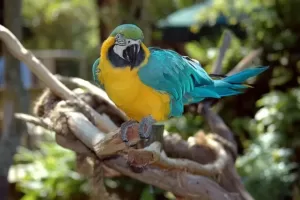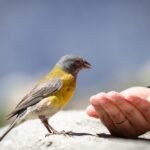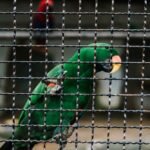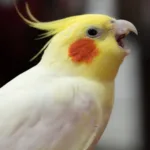Just like how we use words to communicate with each other, parrots rely on vocalizations to convey their thoughts and feelings.
Parrots make many different vocalizations throughout the day and each of them has a meaning they want you to understand.
However, understanding what your parrot is trying to communicate can be hard at times, especially if you’re a new owner.
In this guide, we’ll cover the various sounds that parrots make and their meanings. We’ll also go over the body language signs that accompany these vocalizations to give you a clear understanding.
Quick Navigation
What Do Different Parrot Noises Mean?
| Parrot Sounds | Meaning |
|---|---|
| Screaming | Parrots scream for various reasons, including to express their needs, seek attention, fear, or frustration. |
| Squaking | Squawking noises are danger calls parrots use to alert their flock. |
| Chattering | Parrots chatter most when they want to interact with you. |
| Chirping | Chirping is normal behavior and indicates the parrot is happy. |
| Whistling | Whistling is happy to parrot sound but it can also be that they doing an imitation of the human whistling. |
| Singing | Parrots sing when they’re in a happy mood. |
| Crying | Crying noises represent grief, loneliness, and depression. But sometimes it may also be due to boredom and stress. |
| Hissing | Hissing is a warning sign that signifies territoriality and aggression. |
| Purring | Purring or cooing shows they are content, though sometimes it can mean irritation. |
| Beak Grinding | Beak grinding is a self-soothing behavior that parrots typically do before sleeping. |
| Beak Clicking | Beak clicking can be a sign of anger and territorial behavior or else, it may be a way to relax. |
| Tongue Clicking | Tongue clicking is the same as beak clicking. Certain species of parrots use their tongue to make the clicking sound. |
| Growling | Growling is a clear indication that they are annoyed, angry, or scared. |
| Imitations | Parrots engage in imitation as a form of communication, entertainment, and social interaction. |
Screaming
Of all the noises parrots make, this is probably the one that gets you in the most trouble with your neighbors. Parrots can be loud, even some of the smaller ones.
They can let out high-pitched sounds that can be heard from a distance. Some species of parrots like cockatoos are notoriously loud and their sounds can reach decibel levels that can even harm your hearing.
Screaming is a natural way to communicate for most parrots. It is how they talk to their flock in the wild. Screaming serves many purposes for parrots like, calling for attention, informing their flock of potential dangers, expressing displeasure, and defending their territory.
In general, parrots scream because of fear, aggression, stress, or boredom. Some level of screaming is part of the experience of living with a parrot, but it can become a problem when it gets excessive.
Because the reasons are mostly within the surroundings itself, excessive screaming can easily become a behavioral problem if not corrected in time.
Squawking
Squaking is similar to the high-pitched shrieking noises parrots make when they’re afraid. Mostly, parrots squawk when they sense danger. These sounds are usually used to send danger signals in the wild.
Likewise in captivity, parrots squawk when they feel scared or recognize a threat. It can be anything from an unfamiliar object, a new toy, a bird, or construction noises from 2 blocks away.
When the parrot feels scared, it may exhibit certain body language signs like crouching, flapping its wings, and sometimes screaming.
Chattering
Parrots are little chatter-boxes as you know. So when they’re sitting there doing nothing, you might hear them making all sorts of chattering noises.
Some parrots by nature are more talkative and will not stop making these noises which can be a problem for the neighbors or other family members. But generally, the chattering sounds are sweet and express the parrot’s desire to interact with you.
Chirping
Perhaps the most commonly heard parrot sound every day is the constant chirps. It is a normal vocalization that indicates the parrot is happy and calm in its surroundings. You need not worry about this behavior and enjoy the gentle and melodious chirps.
Whistling
The whistling sound parrots make closely resembles human whistling, having remarkable similarities in tone and rhythm. Whistles often serve as an indicator of the parrot’s positive mood and contentment. Parrots naturally make whistling sounds but they can also learn this from their human companions.
Among the various parrot species, Indian Ringnecks are particularly good at producing this sound. It is often hard to tell the difference between a parrot whistling and a human whistling sound. Though parrots do not just use whistling to communicate their happiness, they also incorporate it into their tuneful songs.
Singing
Parrots love to sing and often bring their own unique style into every song by incorporating squawks, whistles, and chirps. They may not be the most melodious singing birds out there, but they certainly have a knack for singing.
Parrots often use their singing to attract mates in the wild, but they can also use it to keep themselves entertained and happy. They often do this when watching television or when in a jolly mood by themselves.
Crying Noises
Grief and loneliness are the main reasons why parrots cry. It can be the loss of a mate or just someone they felt closely attached to.
Parrots may make crying noises during the nighttime more often but their grieving period continues in the daytime too. Grief is a common reason because like humans parrots can also feel a range of emotions.
However, sometimes parrots may also cry because of boredom and stress as a way to express their sadness. If your parrot feels alone and you aren’t able to devote much time to its care and social needs, then it may feel depressed and lonely.
Hissing
This low-pitched ominous sound is meant as a warning. Hissing can be your parrot’s response to you, other people, or animals. Parrots make these snake-like noises out of fear, territoriality, and annoyance.
When a parrot hisses, it is not a good idea to be anywhere near it, because in this state it will likely not hesitate to bite or show aggression.
In such a situation, it is best to clear its surroundings of potential stressors and try to calm the bird by talking to it in a soothing voice. You should look to find what could be causing such behavior and help your parrot to calm down.
Purring
A purring sound is not a common one. Not all parrots make a purring sound but the ones that do, generally do it out of relaxation. Parrots can be heard making purring noises when they’re content and happy.
When a parrot makes happy purring sounds, it will allow you to pet it and would seem to be in a happy mood. But sometimes, this may also signal irritation and frustration. You need to watch your parrot’s body language to really really understand what kind of purring sound it is making.
Beak Grinding
Many new parrot owners get alarmed over this one because of the screechy nature of the sound. Some even think that their parrot is in pain or has something stuck in its beak. But in reality, it is none of those things.
Beak grinding often indicates contentment and relaxation in parrots. It is commonly seen when they are in a comfortable and secure environment, especially during rest or near their bedtime.
Beak grinding also helps parrots maintain their beaks by keeping them properly trimmed and filed down.
It is perfectly normal behavior that you need not worry about. When your parrot grinds its beak, it is practicing a self-soothing behavior, similar to how we would do a stretch in bed after waking up.
Beak Clicking
Very different from beak grinding, beak clicking is a series of tapping sounds produced when the parrot touches its upper and lower bill repeatedly. A click can be loud or soft depending on what mood your parrot is in.
Clicking sounds can have different meanings but usually, beak clicking is a normal behavior in parrots. Parrots often make clicking sounds when they’re about to sleep. It helps them to relax.
Louder clicking sounds usually represent anger and territorial behaviors. If your parrot feels like you’re encroaching on his space, it might click its beak as a way to tell you to back off. Other times, when a parrot clicks its beak, it is intended to soothe itself.
Tongue Clicking
Tongue clicking is similar to beak clicking in that it is carried out in the same manner. The only difference is that, instead of using the upper and lower bills, the parrot uses its tongue to make the clicking sound.
Cockatoos are most famous for making a tongue-clicking sound. Some parrots like the African Grey can make clicking sounds from their voice box itself without using their beak or tongue.
In some cases though, you need to carefully look where the sound is coming from because a clicking sound can sometimes be a sign of respiratory problems for the parrot.
In such a case, you may not be hearing the sound of the repetitive rattling of the beak. If your parrot makes a clicking sound with its beak open, it is something you should look into.
Growling
There’s no mistaking this sound to be a happy one. A parrot growling is a quite clear sign of warning. More often than not it means that your parrot feels threatened by you and will likely attack if need be.
The growling sounds may be followed by other body language cues such as flapping wings, fluffing up of feathers, and sometimes lunging.
If your parrot growls at someone or you, it is best to take a step back and give it the space it needs. Figure out what might have caused it to get angry and remove that stressor from its environment.
Imitations
Parrots are intelligent birds and quite skilled in mimicking sounds. They might not always know what they are saying but they can eloquently speak any word from any language.
For example, you may talk to them by asking questions that they know the answer to.
Parrots can be taught to associate words with specific actions and responses. Using their intelligence and memory, they can respond to the questions you ask.
This ability comes naturally to some parrots while with others you have to put in a bit of time to teach them.
Regardless of that, all parrots are born communicators and will find ways to get their voices heard. But their mimicking abilities aren’t just limited to that.
Their vocal repertoire comprises a diverse range of sounds, from imitating human speech to musical instruments and even some animal noises. They routinely pick up sounds and noises from their surroundings.
Cockatoos have been observed imitating the barking sound of both dogs and cats and it is quite an impressive imitation.
Like this, parrots can pick up new sounds from their living environment when given the opportunity.
Parrots love to learn and if you spend time with them you can teach them different types of words phrases and sounds.
Final Thoughts
We hope this guide has provided you with insights into understanding your’s parrot different vocalizations. Learning about your parrot’s communication techniques and responding appropriately can help you have a fulfilling relationship with your feathered companions.







